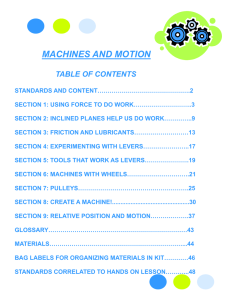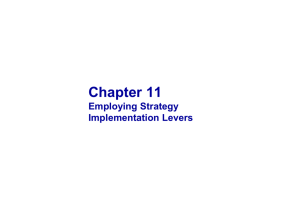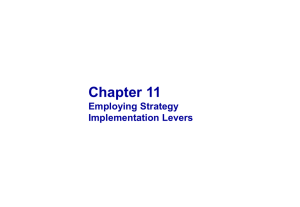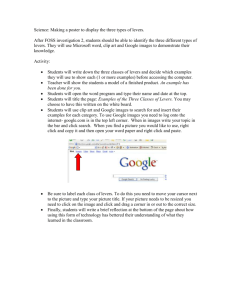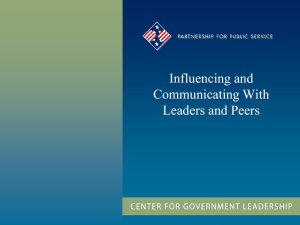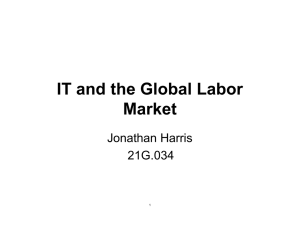Chapter 11 Employing Strategy Implementation Levers
advertisement
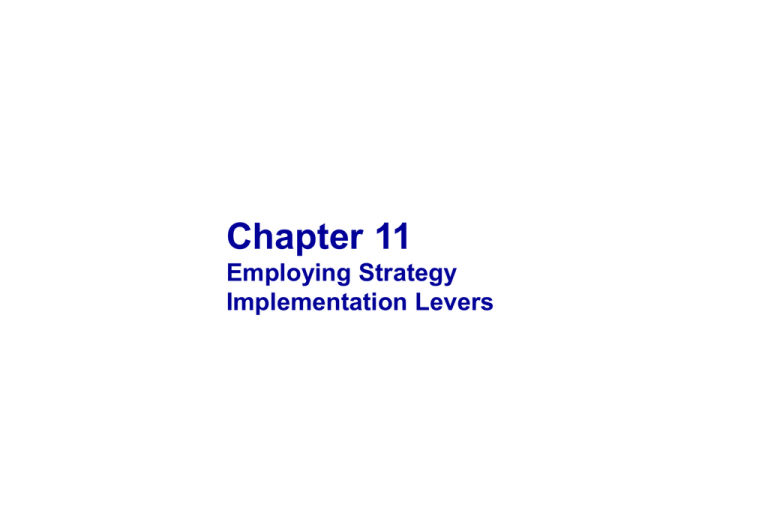
Chapter 11 Employing Strategy Implementation Levers OBJECTIVES 1 Understand the interdependence between strategy formulation and implementation 2 Demonstrate how to use organizational structure as a strategy implementation levers 3 Understand the use of systems and processes as strategy implementation levers 4 Identify the roles of people and rewards as implementation levers 5 Explain the dual roles that strategic leadership plays in strategy implementation 6 Understand how global and dynamic contexts affect the use of implementation levers 1 HUI: SUCCESS AS A JOURNEY …. “the company of choice in all we do today and tomorrow” – Kurt Bell of HUI 2 WL GORE: A STRATEGY OF GROWTH THROUGH INNOVATION Medical products Guitar strings Gore-Tex Dental floss Water filter systems 3 FORMULATION AND IMPLEMENTATION Strategy formulation Strategy implementation The central, integrated, externally oriented concept of how we will achieve our objectives • • • • • Arenas Staging Vehicles Differentiators Economic logic Implementation Levers & Strategic Leadership 4 THREE QUESTIONS Is its strategy flawed? When a firm is experiencing difficulties, its good to ask three questions Is the implementation of its strategy flawed? Are both strategy and implementation flawed? 5 HUI: A MODEL COMPANY Structure A flat structure facilitates the flow of information and fast decision-making. Systems Systems are in place to support the firm’s growth strategy through innovation. People Selection and retention of people are rigorously managed. Culture Selection and retention reinforces a culture that values innovation. 6 KNOWING – DOING GAP Percent of large companies who … … regarded themselves as good or excellent at generating new knowledge … reported having launched new products based on the application of new knowledge 46% 14% (of the same firms) Source: J. Pfeiffer and R.I. Sutton, The Knowing – Doing Gap (Boston: Harvard Business School Press, 2000) 7 CAUSES OF THE KNOWING – DOING GAP: INTERNAL & EXTERNAL RESISTANCE When Compaq tried to copy Dell’s direct-sales model, it met stiff resistance from Comp USA, Best Buy, and other retailers External SAP attempted to launch consulting service to supplement its core technology offering but failed to align with SAP culture Internal • Business units • Culture 8 HOW WOULD YOU DO THAT? – SAP AMERICA • Cultural focus Profitability on costs • Professionalism Revenue Customer service • HR policies • Account “farming” (not just growth) Employees Reputation • Web-based software 9 A CEO’S VIEW ON THE ROLE OF CULTURE “Once IBM was reminded of its core culture, it helped rally the company, bind it together in ways that had been absent for years.” - Lou Gerstner Source: Hambrick and Cannella, “Strategy Implementation as Substance and Selling” 10 KEY FACETS OF STRATEGIC IMPLEMENTATION • Organization structure Systems and processes People and rewards Implementation Levers Realized & Emergent Strategie s Intended Strategy Strategic Leadership • Lever and resource allocation decisions Communicating the strategy to stakeholders 11 ORGANIZATIONAL STRUCTURE ALIGNED TO STRATEGY Organizational structure Strategy • Insures control • Coordinates information, decisions, and activities 12 HOW STRUCTURE INFLUENCES STRATEGY – AIR LIQUIDE Structure Strategy Air Liquide decides to locate personnel at client sites Air Liquide pursues a wealth of new-business opportunities Customer-site employees receive more decision-making autonomy Higher-margin services improve firm performance Customer-site employees see new services Air Liquide could offer (e.g., hazardous material handling, inventory management 13 SIX FORMS OF ORGANIZATIONAL STRUCTURE Functional Multidivisional Matrix Network Partnerships Franchises 14 FUNCTIONAL STRUCTURE Corporate Office Organizes activities according to the specific functions that a company performs Finance Marketing/ Sales Operations R&D Example Platypus Technologies has 30 employees organized into small departments: finance, marketing, HR, and R&D 15 MULTIDIVISIONAL STRUCTURE Headquarters Business Group A Business Group B Business Group C Finance Finance Finance Marketing Marketing Marketing Operations Operations Operations One solution to problems of managing activities in multiple markets or managing multiple products Example GM is organized according to product division (GM Trucks, Chevrolet, Buick, Cadillac, Pontiac, Saturn, etc. Each maintains its own finance, marketing, and other support functions 16 MATRIX STRUCTURE Corporate Office Product or Region A Product or Region B Product or Region C Product or Region D R&D Operations Hybrid between functional and multidivisional structure Marketing Finance Source: http://www.cio.com/archive/090103/hs_reload.html 17 NETWORK STRUCTURE Individual Project group Project group Small, semiautonomous, and potentially temporary groups brought together for a specific purpose Example Gore’s 6,000 employees spread across the world work in small teams and are encouraged to seek out colleagues on their own 18 PARTNERSHIPS AND FRANCHISES Partnerships Franchises The company is organized as a group of partners who own shares or units in the corporation Company not only transfers ownership of local facilities to franchisees, but license all local management responsibility Example Most law firms Example Burger King 19 BALANCED SCORECARD IS A MEASUREMENT SYSTEM TO MANAGE STRATEGY IMPLEMENTATION “To succeed Financial financially, Objectives how should we appear to our shareholders?” “To achieve our vision, how should we appear to our customers?” Measures Targets Initiatives “To satisfy our Internal Business Process shareholders Objectives Measures Targets and customers, at what business processes must we excel?” External Objectives Measures Targets Initiatives Vision and Strategy “To achieve our vision, how will we sustain our ability to change and improve?” Source: Kaplan & Norton, 1996 Learning and Growth Objectives Measures Targets Initiatives Initiatives 20 STRATEGY MAPS HELP LINK ALL PERFORMANCE METRICS TO STRATEGY Implementation levers 21 HOW WOULD I DO THAT? – BALANCED SCORECARD AT US NAVAL UNDERSEA WARFARE CENTER NUWC NUWC Vision: Vision: Be our nation’s provider of choice for forundersea undersea superiority superiority ––satisfying satisfying today’s today’s needs needs and andmeeting meeting tomorrow’s tomorrow’schallenges challenges NUWC NUWC Mission: Mission: We provide the technical foundation foundationwhich whichenables enables the theconceptualization, conceptualization, research, research, development, development, fielding, fielding, modernization, modernization, and maintenance and maintenance of systems of systems that ensure that ensure our navy’s our navy’s undersea undersea superiority. superiority. Financial: To succeed, how must we look to our constituents in terms of balanced budgets, revenue sources, and value? External: To achieve our vision and mission, how must we look to our customers on the dimensions of purpose, service, and quality? Internal: To satisfy our customers, at what business processes must we excel in order to decrease lag time, raise productivity, and lower costs? Employee learning and growth: To accomplish our vision and mission and support internal processes, what kind of staff and information systems do we need to foster innovation, continuous learning, and value in intellectual assets? Implementation levers 22 PEOPLE AND REWARDS People Successful CEOs “attended to people first [and] strategy second. They got the right people on the bus, moved the wrong people off, ushered the right people to right seats – and then they figured out where to drive it” Jim Collins JetBlue and Southwest Airlines both expend considerable effort making sure new hires will fit the firm Rewards Implementation levers 23 PEOPLE AND REWARDS People Rewards Reward systems have two components • Performance evaluation and feedback • Compensation (e.g., salary, bonuses, stock, promotions, coveted office space) They can serve as a force of control over outcomes or behaviors GE which owns several unrelated companies, links division manager pay to the performance of the unit they manage Implementation levers 24 COMMON MANAGEMENT FOLLIES IN REWARD SYSTEMS We hope for… But we often reward for… Long term growth Quarterly earnings Teamwork Individual effort Setting stretch goals Achieving goals Downsizing Adding staff Candor Reporting good new (even if not true) 25 STRATEGIC LEADERSHIP IS RESPONSIBLE FOR 2 KEY OBJECTIVES • Making substantive implementation lever and resource allocation decisions • Communicating the strategy to key stakeholders Strategic Leadership 26 STRATEGIC LEADERSHIP – COMMUNICATING WITH KEY STAKEHOLDERS Convince top management of a new strategy (e.g., Intel’s shift to microprocessors) Upward Win support of other units within the firm Across Managers must sufficiently communicate in 4 directions Outward Win cooperation of external stakeholders including customers and distributors (e.g., Compaq failed to do this with retailers) Downward Enlist support of those who implement Strategic Leadership 27 THREE C’S OF STRATEGY COMMUNICATION C ontacts C ultural understanding C redibility 28 Examples Description STRUCTURAL OPTIONS Multinational configuration Resembles a decentralized federation much like the relationship between US federal government and 50 states SAP pre 1990 International configuration Coordinated group of federations over which more administrative control is exerted by home country headquarters SAP post 1990 Transnational configuration Global configuration Foreign offices are used to access customers, but demand is filled by centralized production Structure allows dispersion, specialization, and interdependence – networked control system Japanese companies 1970s & 1980s McDonald’s Global and Dynamic contexts 29 FIRM RESPONSES TO DYNAMIC CONTEXTS Challenges of dynamic, high-veto city contexts Two common responses • Ambidextrous organization • Patching Global and Dynamic contexts 30 THE AMBIDEXTROUS ORGANIZATION Corporate Office Existing Business Manufacturing Sales Existing organization with historic implementation levers Structural barriers preventing interference and interactions between existing and emerging businesses Emerging Business R&D Manufacturing Sales R&D New organization develops its own levers consistent with the needs of the radical innovation Ambidextrous organizations establish units that are structurally independent from all other units. The emerging business units are to develop their own structures, processes, systems, cultures, strategies, etc. They are only integrated into the mother organization at the level of senior management Global and Dynamic contexts 31 PATCHING Example: HP Laser printing business Patching: regularly remapping businesses in accordance with changing market conditions and restitching them into internal business ventures New technologies New business unit Global and Dynamic contexts 32
